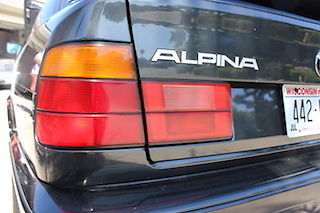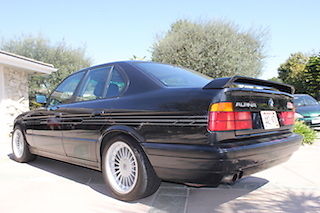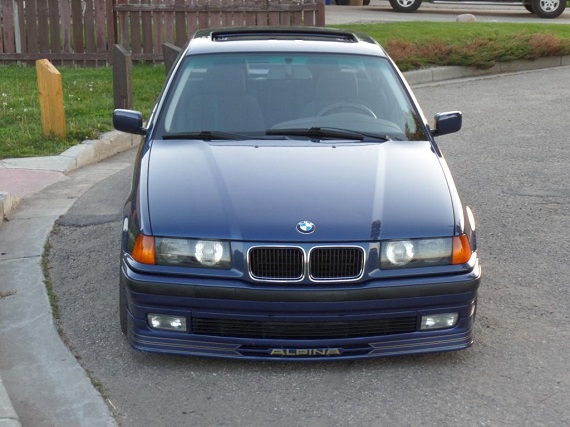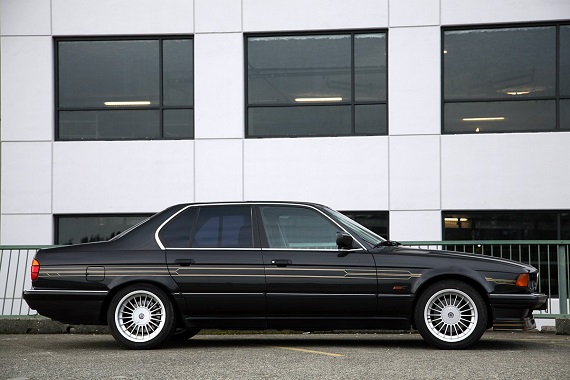Alpina has always struck me as one of the most thorough tuners in the world. Their research and development of engines, suspension and exhaust is second only to perhaps Ruf and AMG, thanks largely to their close associations with the factory. Inside the fit and finish of the cars is perhaps even better than they came originally; beautiful details that make the cars stand apart. And visually Alpinas have always been the best looking BMWs out there in my opinion; subtle aerodynamic tweaks, beautiful wheels and striking but tasteful “go faster” stripes that distinguish Munich’s best. But even amongst Alpinas there are special models, and the E34 B10 BiTurbo is one of them. Alpina took a normal 535i and made it’s own interpretation of what the M5 could be; instead of a high-revving twin cam S38, you got two turbochargers with enough torque to embarrass those boys from Affalterbach. Alpina achieved this through a full custom build; Mahle pistons, custom oil sprayers to cool the them, stronger connecting rods, sodium-filled valves and bespoke intake and exhaust systems – but then, Alpina’s never been shy about producing it’s own items. While all Alpinas are rare, the B10 BiTurbo was fairly popular; of the 1600-odd E34s Alpina built, a full 507 of them were B10s. There are quite a few kicking around Canada, but not many are in the U.S., making this 1993 example quite rare:
Tag: Softlines
While Ruf and AMG grab most of the big tuner headlines from Germany, Alpina quietly and competently produced some of the wildest and best executed BMWs ever made. Simply put, Alpina made already good BMWs better – and arguably still do today. One of the most interesting aspects of the company is the close working relationship they have with the factory; a partnership which results in truly special treatment. Take the Alpina B8 for example; any normal tuner might have simply enlarged the inline-6 under the hood of the already potent M3. Or, in the tradition of the 1980s Alpinas, they could have turbocharged the engine. But instead Alpina asked BMW to make them a special V8. And, somewhat surprisingly, BMW did – a new block was designed for Alpina since the normal 4.0 couldn’t be bored out. The result was a 4.6 liter motor which was fit to the B8 4.6 and B10 as well. The motor was so large in the E36 that a special oil pan had to be designed, and neatly a German camera maker had to be employed to design and build a special oil pump to run it. Yet in true Alpina tradition, the fit and finish was factory and accompanied a host of suspension, interior and aerodynamic tweaks. Capped off by special Alpina paint, these B8s are truly special E36s. While the B8 4.6 is the headline grabber, Alpina built a short run of 5…or perhaps 6….4 liter models that were sold in Japan:
CLICK FOR DETAILS: 1996 Alpina B8 on Bimmerforums
6 CommentsWhile many celebrate the E38 as the highpoint of 7-series design, I prefer the look of the E32. Perhaps that, in part, is because I was lucky enough to live with one for some time – one of the rare ’88 5-speeds, it was a car that I always enjoyed driving and especially enjoyed looking at. Granted, you could rightly claim that the E32 was stylistically not much more than a stretched E34. Is that such a bad thing, though? To me, the design language transferred really well and the E32 was well proportioned, modern looking and yet immediately identifiable as a large BMW,and yet muscular flares and a slight tick up in the body line towards the trunk was a built-in spoiler. The E38 took this design and refined it even more, with sleeker lines and a more dramatic drop in front – probably one of the main reasons, along with some killer wheels, that people prefer the later design. But outfit an E32 with lower suspension, a deeper air dam and some killer wheels, and the design is pretty awesome. The stripes don’t hurt, either – nor does the top-tier name Alpina painted all over:
CLICK FOR DETAILS: 1990 Alpina B11 3.5 on eBay
4 CommentsEuro cars always hold a special appreciation for me, especially from the 1970s and 1980s. First off, they were much better looking, generally with slimmer bumpers and larger, more clear class lights. There were colors and interiors that we didn’t get in the U.S. as well, helping to set yourself apart. Sometimes there were low-spec engines not imported, but usually the output of the motors that were similar to U.S. cars was higher, giving more performance to enthusiasts. Sometimes that gulf was huge; while usually around 10% higher, a great example is the Quattro which was a full 25% more powerful in Europe than the U.S. restricted version. But as we got towards the late ’80s, the gap inbetween both the looks and performance of the Euro models versus the U.S. models closed steadily. True, in some cases we still didn’t get the full-fat versions of cars like the M3 until the E46 chassis. But for most models, there was a negligible difference. When it came to the BMW E31, in fact, there were almost no differences between the U.S. models and European models; styling was exactly the same, as were the wheels, most of the colors and interiors, and the basic suspension and engine. So, it’s just not nearly as exciting to see a European-spec newer model like this ’91 850i pop up for sale, though it is a bit odd:
CLICK FOR DETAILS: 1991 BMW 850i Euro on eBay
2 CommentsThe 1989 E32 Alpina B11 3.5/1 from January is back! After failing to sell in a reserve auction, the seller has moved to a no reserve format and with about two days to go, this rare 7 has crested $10,000. Last time around I guessed that the car would struggle to break past $12,000 – around where I thought the reserve was set. Where do you think it will end up?








